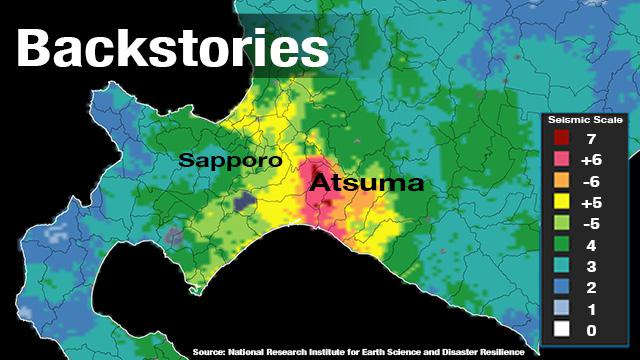Experts discuss the mechanism
Kei Katsumata, a seismologist at Hokkaido University, says an active fault called the Ishikari Teichi To-en zone is located near the epicenter, but he expressed doubt about a direct link between the fault and the quake. "The epicenter was 40 kilometers underground, while the fault is about 10 kilometers deep," Katsumata pointed out.

He says Thursday's magnitude 6.7 earthquake occurred in an area where stress is known to accumulate underground. A strong earthquake occurred there in July of last year.
Katsumata says that the earthquake may have been caused by pressure that built up in the area surrounding the fault. There's constant upward pressure toward the nearby Hidaka Mountain Range there. He warned, "Pent-up pressure may not necessarily be released in one earthquake, and that over the next week or so, the area may have several more earthquakes just as powerful as the one on Thursday."
Members of the government's task force also discussed whether Thursday's quake originated in the fault zone. But they concluded it did not, given the distance from the fault zone to the epicenter. The leader of the task force team, University of Tokyo Professor Naoshi Hirata, warns that "More inland quakes, both close and far from the active fault, could occur as a result of Thursday's quake." He says he wants people to know strong earthquakes can occur in any inland part of Japan regardless of whether there is an active fault. "A maximum-level quake could hit," he said.
Rescue work continues over night
Rescuers are searching for missing people around the clock in the town of Atsuma, near the epicenter.
The quake measured the strongest possible level on Japan's seismic intensity scale in the town, triggering massive landslides over 2 kilometers that wiped out homes. Five people died there and all 26 of the missing people are from this area.
Rescuers are digging through rubble and mud in their search for survivors. A platoon leader of the Japanese Self-Defense Forces said they have been working through the night. "It's hard to find the many people who remain buried. We want to rescue them as quickly as possible." A man living nearby said, "I'm worried about my neighbors. I want rescuers to find them fast."
Japanese Chief Cabinet Secretary Yoshihide Suga said the government is making an all-out effort. "Police, firefighters, and members of the Self-Defense Forces and Coast Guard are placing top priority on saving lives. Together with the help from outside the prefecture, 22,000 personnel and 75 helicopters are working around the clock," he said.
An expert analyzed footage of the landslides. Hiroyuki Ohno, the head of the Sabo and Landslide Technical Center says the soft surface of the mountains gave way. "The surface may have contained volcanic ash, making it prone to crumbling," Ohno said.
He also says the exposed surface absorbs rainwater, making it even more likely to collapse, so people in the quake-hit areas should be careful of secondary disasters.
There have been more than 90 aftershocks. Meteorological Agency officials are warning that strong tremors could hit the region again over the coming week.
To make matters worse, rain is forecast to drench Hokkaido starting on Friday. Officials are warning it may trigger further landslides.
Evacuees spend night at shelters
Thousands of people have evacuated to shelters set up throughout the prefecture. Officials have issued requests to supermarkets and convenience stores for supplies of food and water because emergency provisions are running low.
Evacuees were comforted by the hot meals they were served in the morning.
A person at the shelter in Atsuma said, "I couldn't sleep last night as my relative is still missing in the mud and there have been so many tremors."
Another person at the shelter described how hard the night was. "I feel safer here. My home is dark because of the blackout, and it's scary. It's been a while since I had food like this, because I couldn't eat anything last night," she said.

